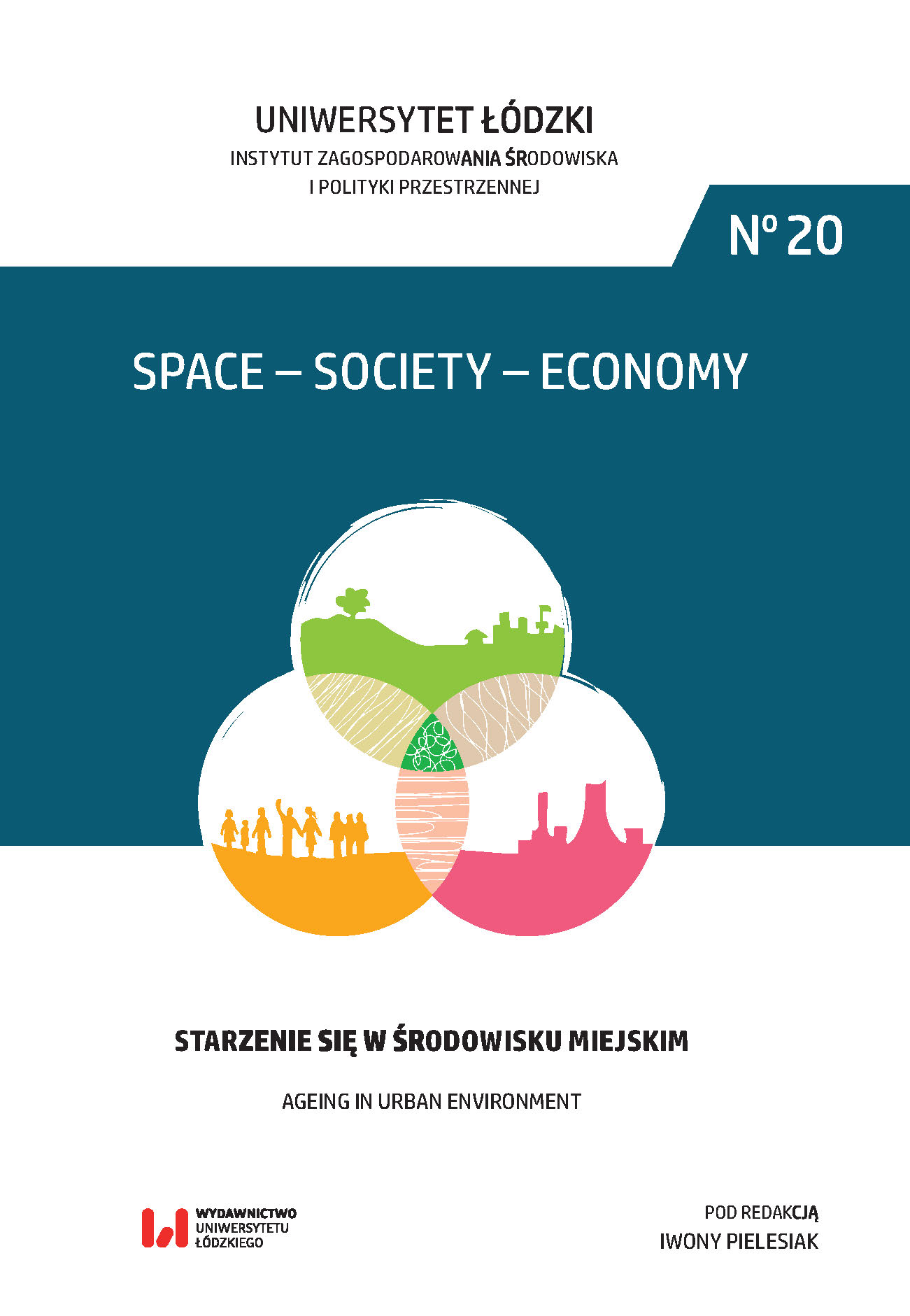Patterns of activities among Cracow’s young retirees in an urban environment(an example of cluster analysis)
DOI:
https://doi.org/10.18778/1733-3180.20.05Keywords:
cluster analysis, retirement, lifestyle, ageing, urban studies, social gerontologyAbstract
Population ageing has drawn increasingly more attention to the question of retirement. On the one hand, the number of retirees increases and retirement becomes a more prominent part of life. As a result, people at present have developed a distinct retirement lifestyle and retirees become more diverse. This study presents how the choices of young retirees (individuals that are retired for no longer than 10 years) in urban environment differ. The empirical material used for this study consisted of 206 interviews conducted with inhabitants of Cracow. Interviews were conducted from June to December 2014. Hierarchical cluster analysis enabled to differ two type of time usage models (traditional and open) and 3 types of young retirees (active retirees residing in districts that have a wide offer dedicated to senior citizens, passive retirees with limited funds and moderately active older young retirees).
Downloads
References
Altman I., Low S.M., 1992, Attachemment to place and representation of life course by the elderly, [w:] Altman I., Low S.M. (red.), Place attachment, Plenum Press, New York: 39–163.
Google Scholar
DOI: https://doi.org/10.1007/978-1-4684-8753-4
Bernard M., Phillipson C., Phillips J., Ogg J., 2001, Continuity and Change in the Family and Community Life of Older People, „Journal of Applied Gerontology”, 20 (3): 259–278.
Google Scholar
DOI: https://doi.org/10.1177/073346480102000301
Bonvalet C., Ogg J., 2008, Ageing in Inner Cities. The Residential Dilemmas of the Baby Boomer Generation, „International Journal of Ageing and Later Life”, 2 (2): 61–90, https://doi.org/10.3384/ijal.1652-8670.072261
Google Scholar
DOI: https://doi.org/10.3384/ijal.1652-8670.072261
Brown S.C., Mason C.A., Lombard J.L., Martinez F., Plater-Zyberk E., Spokane A.R., Szapocznik J., 2009, The Relationship of Built Environment to Perceived Social Support and Psychological Distress in Hispanic Elders: The Role of „Eyes on the Street”, „The Journals of Gerontology”, Series B: Psychological Sciences and Social Sciences, 64B (2): 234–246, https://doi.org/10.1093/geronb/gbn011
Google Scholar
DOI: https://doi.org/10.1093/geronb/gbn011
Carp F., Carp A., 1984, A Complementary/Congruence Model of Well-Being or Mental Health for the Community Elderly, [w:] Altman I., Lawton Wohlwill M.P., Joachim F. (red.), Elderly people and the environment, t. 7, Plenum Press, New York: 279–336, http://dx.doi.org/10.1007/978-1-4899-2171-0
Google Scholar
DOI: https://doi.org/10.1007/978-1-4899-2171-0
Dzięgielewska M., 2006, Wolontariat ludzi starszych (na przykładzie wolontariuszy w regionie łódzkim, [w:] Steuden S., Marczuk M. (red.), Starzenie się a satysfakcja z życia, Wydawnictwo KUL, Lublin.
Google Scholar
Elder G. Jr., Johnson M., Crosnoe R., 2003, The Emergence and Development of Life Course Theory, [w:] Mortimer J., Shanahan M. (red.), Handbook of the Life Course, Springer US: 3–19, http://dx.doi.org/10.1007/978-0-306-48247-2_1
Google Scholar
DOI: https://doi.org/10.1007/978-0-306-48247-2_1
Feldman D.C., Beehr T.A., 2011, A three-phase model of retirement decision making, „American Psychologist”, 66 (3): 193–203, https://doi.org/10.1037/a0022153
Google Scholar
DOI: https://doi.org/10.1037/a0022153
Haase A. (red.), 2011, Residential change and demographic challenge: the inner city of East Central Europe in the 21st century, VT Ashgate, Farnham, Burlington.
Google Scholar
Hague C., Jenkins P. (red.), 2005, Place identity, planning and participation (1st ed), Routledge, London–New York.
Google Scholar
Halicka M., Pędich W., 1997, Działania samopomocowe ludzi starszych, Akademia Medyczna w Białymstoku, Białystok.
Google Scholar
Harvey D., 2008, The Right to the City, „New Left Review”, 53: 23–42.
Google Scholar
Jałowiecki S., 1973, Przejście na emeryturę jako proces zmian aktywności społecznej, Zakład Narodowy im. Ossolińskich, Wrocław–Kraków–Warszawa–Gdańsk.
Google Scholar
Klimczuk A., 2012, Kapitał społeczny ludzi starych na przykładzie mieszkańców miasta Białystok, Wiedza i Edukacja, Lublin.
Google Scholar
Krzyżanowska Ł., 2011, Urlop czy zesłanie – stosunek Polaków do emerytur, [w:] Mucha J., Krzyżowski Ł. (red.), Ku socjologii starości. Starzenie się w biegu życia jednostki, Wydawnictwo AGH, Kraków.
Google Scholar
Krzyżowski Ł., 2011, Strategie przechodzenia na emeryturę w Polsce po 1989 roku. Oczekiwania społeczne i praktyki kulturowe, „Studia Socjologiczne”, 2 (201): 165–189.
Google Scholar
Krzyżowski Ł., Kowalik W., Suwada K., Pawlina A., 2014, Młodzi emeryci w Polsce: między biernością a aktywnością, Wydawnictwo Naukowe Scholar, Warszawa.
Google Scholar
Lefebvre H., 1991, The production of space, t. 142, Blackwell, Oxford.
Google Scholar
Liwiński J., 2008, Dezaktywizacja osób w wieku okołoemerytalnym: Raport z badań, Departament Analiz Ekonomicznych i Prognoz, Ministerstwo Pracy i Polityki Społecznej, Warszawa.
Google Scholar
Moen P., 1996, A life course perspective on retirement, gender, and well-being, „Journal of Occupational Health Psychology”, 1 (2): 131–144, https://doi.org/10.1037/1076-89-98.1.2.131
Google Scholar
DOI: https://doi.org/10.1037/1076-8998.1.2.131
Morgan L., Kunkel S., 2001, Ageing.the social context, Pine Forge Press, California.
Google Scholar
MPiPS, 2012, Osoby powyżej 50 roku życia na rynku pracy, http://www.mpips.gov.pl/analizy-i-raporty/raporty-sprawozdania/rynek-pracy/sobypowyej50rokuycianarynkupracy/rok-2012/
Google Scholar
Niezabitowska E., Bartoszek A., Kucharczyk-Brus B., Niezabitowski M., 2012, Środowisko zamieszkania polskich seniorów – rozpoznanie problematyki w badaniach interdyscyplinarnych, Śląsk, Katowice.
Google Scholar
Niezabitowski M., 2011, Relacje społeczne ludzi starszych w środowisku zamieszkania – aspekty teoretyczne i empiryczne, „Acta Universitatis Lodziensis. Folia Sociologica”, 38: 13–31.
Google Scholar
Niezabitowski M., 2012, Elderly people in residential environment, [w:] Perek-Białas J., Hoff A. (red.), Developing the „Sociology of ageing” to tackle the challenge of ageing societies in Central and Eastern Europe, Wydawnictwo Uniwersytetu Jagiellońskiego, Kraków: 139–162.
Google Scholar
Perek-Białas J., Hoff A., 2012, Developing the „Sociology of ageing” to tackle the challenge of ageing societies in Central and Eastern Europe, [w:] Perek-Białas J., Hoff A. (red.), Developing the „Sociology of ageing” to tackle the challenge of ageing societies in Central and Eastern Europe, Wydawnictwo Uniwersytetu Jagiellońskiego, Kraków: 7–11.
Google Scholar
Rodwin V., Gusmano M.K. (red.), 2006, Growing older in world cities: New York, London, Paris and Tokyo (1st ed), Vanderbilt University Press, Nashville.
Google Scholar
DOI: https://doi.org/10.2307/j.ctv16h2hrk.5
Savage M., Warde A., Ward K., 2003, Urban sociology, capitalism and modernity (2nd ed), Palgrave Macmillan, London.
Google Scholar
DOI: https://doi.org/10.1007/978-1-137-07810-0
Scharf T., 2002, Growing older in socially deprived areas: Social exclusion in later life, http://vmserver14.nuigalway.ie/xmlui/handle/10379/3196
Google Scholar
Scharf T., Phillipson C., Smith A., 2003, Scharf, Phillipson and Smith: Older People’s Perceptions of the Neighbourhood, http://www.socresonline.org.uk/8/4/scharf.html (dostęp: 23.05.2013).
Google Scholar
DOI: https://doi.org/10.5153/sro.867
Smith A.E., 2009, Ageing in urban neighbourhoods: place attachment and social exclusion, Policy, Bristol.
Google Scholar
DOI: https://doi.org/10.2307/j.ctt9qgmn1
Stankiewicz K., Richert-Kaźmierska A., 2012, Czynniki motywujące osoby w wieku okołoemerytalnym do wydłużonej aktywności zawodowej, „Prace Naukowe Uniwersytetu Ekonomicznego we Wrocławiu = Research Papers of Wrocław University of Economics”, 249: 236-246, Wydawnictwo Uniwersytetu Ekonomicznego we Wrocławiu.
Google Scholar
Synak B., 1987, Młodzi emeryci, Instytut Wydawniczy Związków Zawodowych, Warszawa, http://opac.ciniba.edu.pl/0192303562301/synak-brunon/mlodzi-emeryci
Google Scholar
Temelová J., Slezáková A., 2014, The changing environment and neighbourhood satisfaction in socialist high-rise panel housing estates: The time-comparative perceptions of elderly residents in Prague, „Cities”, 37: 82–91, https://doi.org/10.1016/j.cities.2013.12.002
Google Scholar
DOI: https://doi.org/10.1016/j.cities.2013.12.002
Trafiałek E., 1998, Życie na emeryturze w warunkach polskich przemian systemowych, Wydawnictwo Wyższej Szkoły Pedagogicznej w Kielcach, Kielce.
Google Scholar
WHO, 2007, Global age-friendly cities a guide, World Health Organization, Geneva, http://site.ebrary.com/id/10214515
Google Scholar
Woźniak Z., 1997, Najstarsi z poznańskich seniorów. Jesień życia w perspektywie gerontologicznej, Urząd Miasta Poznania, Poznań.
Google Scholar
Zaniewska H., 2001, Mieszkania starych ludzi w Polsce. Sytuacja i perspektywy zmian, Instytut Gospodarki Mieszkaniowej, Warszawa.
Google Scholar
Downloads
Published
How to Cite
Issue
Section
License

This work is licensed under a Creative Commons Attribution-NonCommercial-NoDerivatives 4.0 International License.









